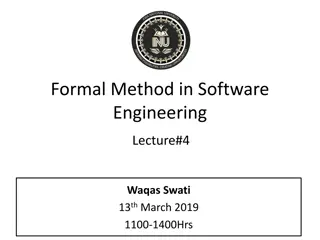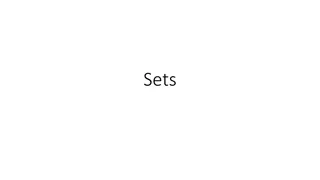Understanding Set Operations
Explore the concepts of set operations including union, intersection, disjoint sets, cardinality of unions, and the difference of two sets. Learn definitions, examples, and applications of these fundamental set theory operations.
Download Presentation

Please find below an Image/Link to download the presentation.
The content on the website is provided AS IS for your information and personal use only. It may not be sold, licensed, or shared on other websites without obtaining consent from the author. Download presentation by click this link. If you encounter any issues during the download, it is possible that the publisher has removed the file from their server.
E N D
Presentation Transcript
The Union DEFINITION 1 Let A and B be sets. The union of the sets A and B , denoted by A U B , is the set that contains those elements that are either in A or in B , or in both. An element x belongs to the union of the sets A and B if and only if x belongs to A or x belongs to B . This tells us that A U B = {x | x A V x B } .
EXAMPLE 1 The union of the sets {1,3,5} and {1,2,3} is the set {1,2,3,5} ; that is, {1,3,5} U {1,2,3} = {1,2,3,5} .
The Intersection DEFINITION 2 Let A and B be sets. The intersection of the sets A and B , denoted by A B , is the set containing those elements in both A and B . An element x belongs to the intersection of the sets A and B if and only if x belongs to A and x belongs to B . This tells us that A B = {x | x A x B } .
EXAMPLE 3 The intersection of the sets {1,3,5} and {1,2,3} is the set {1,3} ; that is, {1,3,5} {1,2,3} = {1,3} .
Disjoint Sets DEFINITION 3 Two sets are called disjoint if their intersection is the empty set. EXAMPLE 5 Let A = {1,3,5,7,9} and B = {2, 4, 6, 8 , 10} . Because A B = , A and B are disjoint.
The Cardinality Of a Union Of Two Finite Sets Note that I A I + I B I counts each element that is in A but not in B or in B but not in A exactly once, and each element that is in both A and B exactly twice. Thus, if the number of elements that are in both A and B is subtracted from IAI+ IBI , elements in A B will be counted only once. Hence, I A U B I = I A I + I B I - I A B I . The generalization of this result to unions of an arbitrary number of sets is called the principle of inclusion-exclusion.
The Difference Of Two Sets DEFINITION 4 Let A and B be sets. The difference of A and B , denoted by A - B , is the set containing those elements that are in A but not in B . The difference of A and B is also called the complement of B with respect to A. An element x belongs to the difference of A and B if and only if x A and x B . This tells us that A - B = {x | x A x B } .
EXAMPLE 6 The difference of {1,3,5} and {1,2,3} is the set {5}; that is, {1,3,5} - {1,2,3} = {5} . Caution! This is different from the difference of {1,2,3} and {1,3,5} , which is the set {2}. {1,2,3}- {1,3,5} = {2}.
The Complement Of a Set DEFINITION 5 Let U be the universal set. The complement of the set A , denoted by , is the complement of A with respect to U. In other words, the complement of the set A is =U-A. An element belongs to if and only i f x A . This tells u s that = {x | x A } .
Homeworks Page 130 3 (a,b,c,d) 14 19 25 (a,c) 59























